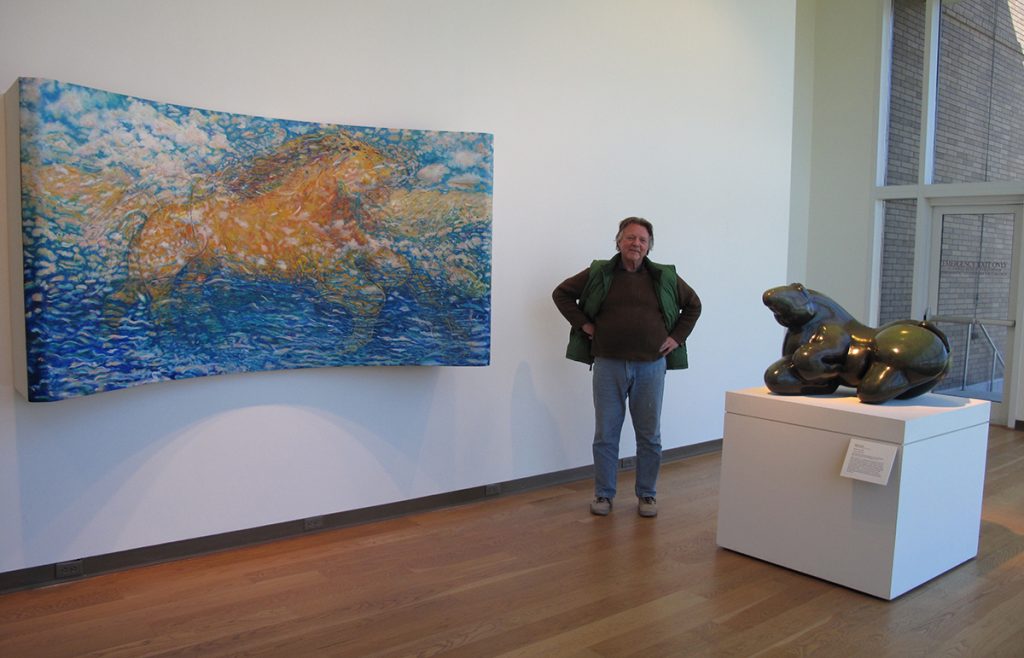William Schaaf has never treated art as decoration. For him, it’s a process—of making, remembering, and healing. Now 80, he’s still in his studio, still forming horses from bronze, canvas, and clay with the same intent that’s guided him for over sixty years. Horses are his subject, yes, but they’re also a kind of language. They carry memory, power, and spirit. Schaaf’s relationship with the equine form is personal and spiritual, shaped by a long-standing respect for Zuni and Navajo fetish traditions. His work reaches back into those practices not to replicate them, but to honor their deeper purposes: healing, presence, and connection.

Schaaf’s sculptures and paintings aren’t built to impress—they’re built to resonate. His materials—often bronze patinated to resemble jade or turquoise—echo the mineral textures of medicine stones. His art invites contact, asks to be touched, and offers something quiet in return.
One of his best-known sculptures is Tantra Gurl, a 36-inch bronze “power horse.” She lives in the collections of three Florida museums, though Schaaf describes her less like a static piece and more like a living object. She was created as a fertility fetish made large, with every line and surface carrying intention. The patina mimics the sheen of sacred stones, giving her a soft, weathered finish. Schaaf calls the process of patination “watercoloring with fire and chemicals”—a fitting metaphor for a piece that walks the line between earth and spirit.

Tantra Gurl isn’t a passive object. She’s been invited into places where her energy matters—like a breeding farm in Kentucky, where she stood as a talisman. During her time at the Harn Museum of Art in Gainesville, visitors couldn’t stop touching her. Schaaf encouraged this. He even suggested they wear cotton gloves and polish her as a gesture of connection. But not everyone was comfortable with her presence. Her sensual lines and spiritual charge made some uneasy, and eventually, the museum moved her into storage. She spent years out of view, hibernating underground.

Her story is full of close calls. The original clay version was nearly lost before it was ever cast. Made to fit a kiln that had been built for her dimensions, she was shaped with too much water and nearly collapsed during an unexpected cold snap. Schaaf and his team wrapped her in electric blankets to keep the clay from cracking. Then the kiln exploded, damaging the sculpture and ending any hope of firing it. The collector who commissioned the piece walked away. But another collector, having watched the whole ordeal unfold, stepped in and offered to cast the piece in bronze—along with two others. Schaaf still sees that moment as a gift. Fortunata, he says. A stroke of luck.
Schaaf’s River Horse painting, held by the Orlando Museum of Art, offers a different mood. Painted in oil, it feels quieter and more reflective. Where Tantra Gurl demands physical engagement, River Horse offers something gentler—like a memory surfacing, then fading. It’s a piece you feel before you see. Schaaf doesn’t aim for realism here. He paints presence, not anatomy.
Across mediums, Schaaf returns to the idea of the horse as medicine—not as cure, but as something to sit with. His work isn’t afraid of discomfort or vulnerability. It touches on the erotic and the spiritual without separating the two. In his bronzes, you can feel the weight of ritual. In his paintings, you get something more private—still sacred, but quiet.
Schaaf’s connection to Indigenous art isn’t about borrowing style. It’s about understanding intention. He sees the energy that lives in an object when it’s made with care, and he tries to make his own work in that same spirit. His respect for these traditions is steady and long-held.
At 80, there’s no sense that Schaaf is winding down. His studio is still full. His hands still move through clay and chemicals, shaping stories into form. The horses keep coming. Some bold, some spectral. Each one a new attempt to hold what can’t be spoken. That’s what Schaaf has always been doing—holding space. For the sacred. For the broken. For the parts of life that don’t fit neatly into words.

